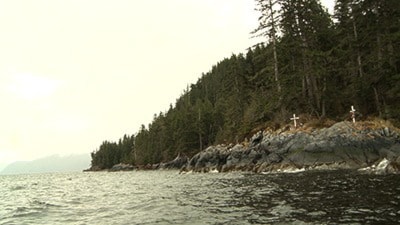Coastal Tarsands: The Dangers of West Coast Oil Tankers, a series of 10-minute vignettes currently in production by documentary filmmaker Richard Boyce, will explore bite-sized chunks of an issue that is overloading many — tankers in B.C.’s coastal waters.
The saturation isn’t surprising as Enbridge has spent $350 million on its current pipeline public relations campaign.
“Enbridge seems to have a monopoly on those beautiful little vignettes we see on TV,” Boyce says. “These places are very remote, so most of us can’t get there to see for ourselves.”
According to Boyce, those “beautiful little vignettes” are part of the problem. The digital versions we see on TV don’t accurately portray the narrow passageways and potential surge tides these behemoths may face.
“When you try to put a super tanker through an area that’s slightly larger than it,” says Boyce, “there are all kinds of problems the environment can throw at it ... the storms, the reefs, the surge channels, the narrow passages between islands where they’ll need to make sharp 90-degree turns.”
If Boyce sounds overly concerned about the ships, he is — but not just for their safety or the pollution they could produce. The thought of losing the landscape is what pains him greatly.
“These are incredibly lush places. This is where the hooligans go. The shorelines in all these inlets are where the clams go and the herrings nest.”
When the passenger ferry, the Queen of the North, went down along today’s proposed route in 2006, locals couldn’t eat the clams for three years. Complicating the issue further, each of the super tankers is registered as its own corporation, making them individually responsible for any damage — not their parent companies. Brokers like Lloyds of London, who insure them on the premise that there will be a spill, individually underwrite each tanker.
“An oil spill is just part of doing business,” Boyce says.
That’s where Coastal Tarsands’ 10-minute vignettes come in. Boyce says although there have been many documentarians in the area focusing on Enbridge, he hasn’t seen much about the natural landscape. One of his vignettes will travel along Enbridge’s proposed route from Kitimat through the inside passage, along the Douglas Channel, across Hecate Strait to the Pacific Ocean. Another will travel to Kitimat and get local reactions to the industry building there. Boyce will also take a look at fisheries and seaweed harvests by indigenous groups as well as spending time in narrow channels to capture swells that can reach 90 feet.
That covers about 40 minutes of the proposed 100 minutes of film. There’s another aspect of this new style of filmmaking that has this seasoned creator and activist excited. “Each vignette also has the possibility for input so people can shine light on something I may have missed,” he says.
As each vignette is completed, it will be posted online. Eventually they will all be edited together, but Boyce hopes the gradual rollout will serve to spark, maintain and generate interest throughout the project.
“There is a sense out there that somehow this pipeline is not going to happen. People need to know that is short sighted,” Boyce acknowledges. “They’re not going to go away. They want to make trillions of dollars.” M
To see the beginnings of a truly unique documentary filmmaking experience and to donate and help Costal Tarsands complete its goal, visit coastaltarsands.ca.
